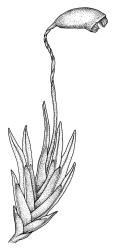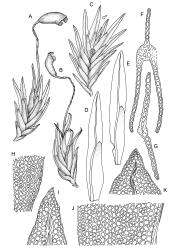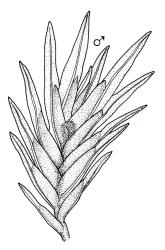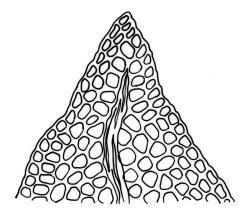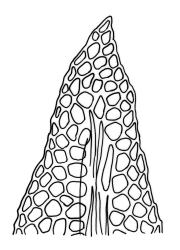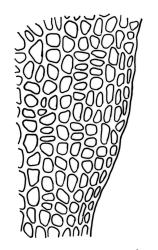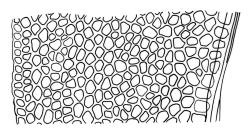Plants 3–15(–35) mm, pale to dark grey-green, reddish when senescent, tufted or densely gregarious. Stems occasionally branched by means of axillary innovations from below terminal gametoecia or from moribund shoots, with rhizoids at shoot bases. Leaves in 5–10(–17) pairs, overlapping at mid stem, erect-spreading, plane when moist, glossy and little altered with apices usually undulate and curved away from the substrate (or rarely inrolled) when dry, linear-lanceolate, (1.6–)2.5–3.5 × 0.3–0.7 mm; apex acute to acuminate; laminae unistratose; vaginant laminae ½–⅔ leaf length, partially closed; dorsal lamina ending at leaf insertion, tapered to its base; margins entire to minutely serrulate, sinuous towards the leaf apex; cells of apical and dorsal laminae irregularly rounded-hexagonal, ± isodiametric, smooth, slightly bulging, with moderately thick walls, (8–)10–15(–18) × (8–)10–15(–18) µm. Costa failing 3–6 cells below the leaf apex, oblongifolius-type in cross-section.
Dioicous. Perichaetia terminal; perichaetial leaves with apical and dorsal laminae narrowed. Perigonia terminal on tall plants. Setae orange-brown, slender, strongly twisted, tortuose above when dry, 3–8 mm; capsules horizontal, arcuate, 1.0–1.3 mm; operculum rostrate from a conic base, equal in length to theca. Peristome modified similiretis-type, with irregularly pitted plates on the abaxial lamellae, and trabeculae often well-developed throughout the filaments; teeth 52–84 µm wide at base. Calyptra smooth, mitrate. Spores 9–12 µm.
Wilson 1854, pl. 83, fig. 7; Scott & Stone 1976, pls 7–9 (pro parte); Beever & Stone 1998, figs 1, a–s, 2, a, 7, a; Beever et al. 2002, p. 52, figs 1–6.
NI: N Auckland, including offshore islands (LB), S Auckland, Gisborne, Hawke’s Bay (Ruahine Ranges), Taranaki, Wellington (including KA); SI: Nelson (including D’U), Marlborough, Canterbury, Westland, Otago; St; Ch.
Australasian? Tasmania*, mainland Australia (eastern states only)*, New Caledonia*. Also recorded from Malesia by Bruggeman-Nannenga et al. (1994).
Common on soil in indigenous forests. The species is an early coloniser of disturbed bare earth, such as on the soil around roots of wind-thrown trees, and in slightly overhung sites on track-side or stream-side banks. Associated mosses include Ditrichum difficile, Distichophyllum pulchellum, F. linearis var. angustifolius, F. tenellus, and Mittenia plumula.
Records range from sea level to c. 650 m.
A specimen from Otago (B. Polly s.n., WELT M027735) has leaf margins irregularly denticulate towards the leaf apex, and many leaf apices are inrolled away from the substrate when dry, rather than merely undulate or curved. Similar plants are found in Australia, especially in Tasmania (e.g., HO 300480), where variability in this taxon is much greater than that seen in N.Z.
Dixon (1923, pp. 105–106) tentatively placed F. knightii Reichardt in synonymy of F. pallidus. Examination of the type by Beever & Stone (1998) showed, however, that it is a synonym of F. asplenioides Hedw., with the bulging lamina cells, crenulate leaf margins, and the obtuse leaf apices of the latter species.
Pursell & Bruggeman-Nannenga (2004) comment that "Fissidens pallidus … has conspicuous axillary nodules" but these are lacking in N.Z. material, including the type.
An account of F. pallidus in N.Z. was given by Beever & Stone (1998).



